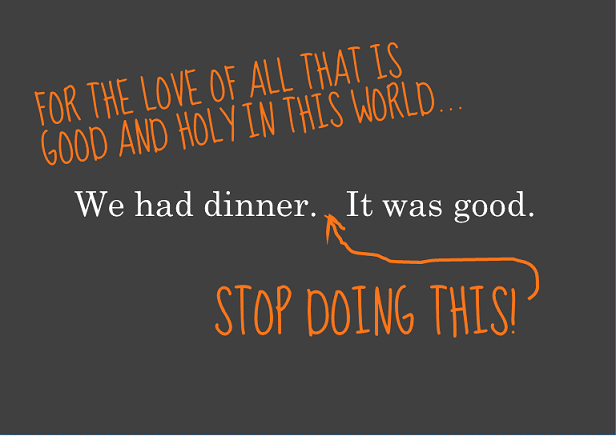Nothing Says Over 40 Like Two Spaces after a Period!

(Before I start, I should mention that I am over 40.)
I learned to type in 1987 on an IBM Selectric typewriter. A typewriter, not a computer. We had those, but they had big, actually floppy disks and honest to God, no one had any idea what to do with them. My semester of typing remains one of the most valuable classes I ever took in high school — I can still dazzle small children with my ability to make words appear on a screen by just hysterically wiggling my fingers on the keyboard.
But one rule from typing class has definitely expired, and if you’re over 40, it’s possible that no one has given you the message. Here it is:
Unless you are typing on an actual typewriter, you no longer have to put two spaces after a period.
Or a question mark. Or an exclamation point. The rule applies to all end punctuation. Just one space. Really.
Yes, really.
Here’s why: Back when we used typewriters, every character was given the exact same amount of space on the page. That meant the letter i was given the same amount of space as the letter m, even though it clearly didn’t need it. This is called monospaced typesetting and it’s, well, spacey. We needed that extra space between sentences to make it easier to see the beginning of new sentences.
Word processors and computers and everything that is not a very old typewriter use mostly proportionally spaced fonts, which adjust spacing to the size of the letter. That’s why a proportional font can squeeze 12 letters into the same space where a monospace font can only fit nine:

If you do even a little bit of research on this topic, you’ll find plenty of articles practically begging you to stop using two spaces. Slate‘s Farhad Manjoo went so far as to say that it is totally, completely, utterly, and inarguably wrong.
But these articles are not reaching everyone, probably because for many of us who learned to type before computers, it was hammered into our heads over and over and OVER again to use two spaces. We got our papers marked wrong if we didn’t. It takes a long time to unlearn that. And until you unlearn it, you’ll probably force this funky old rule on your own students. I know I did: I remember sitting in a computer lab in 1998, going through my students’ papers, marking all the places where they needed to add an extra space after the period. It wasn’t until 1999, when I got a copyediting job with the New England Journal of Medicine, that I learned the “new” rule.
When you know better, you do better. I love you, fellow middle-aged folks, but it’s time we all join the modern age and spend just a little less time leaning on the space bar.
That is all. ♦
[Actually, that is NOT all! See my follow-up post, written two months later…The Price of Snark: What I Learned About Teaching from a Viral Post.]
For the most part, this site is about teaching. So if you happened upon this article AND you have an interest in education, you need to stick around, baby. Join my mailing list and get weekly tips, tools, and inspiration — in quick, bite-sized packages — all geared toward making your teaching more effective and joyful. To thank you, I’ll send you a free copy of my new e-booklet, 20 Ways to Cut Your Grading Time in Half. I look forward to getting to know you better!
//
//